| |

Traditions, folklore, history and more. If it's Irish, it's here. Or will be!
"People will not look forward to posterity who never look backward to their ancestors."
-Edmund Burke




Quotes
Library: Books, Movies, Music
Prints & Photos
Poetry
Jokes


Shops Ireland
Bunús na Gaeilge
(Basic Irish)
Circle of Prayer
Blessings
Did You Know?
Himself/Herself
Write to Us
Readers Write..
Links/Link to Us
Advertise with us
Awards & Testimonials
Submissions Guide

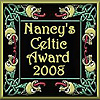
|
|
|
It's a long way to Tipperary
by Bridget Haggerty
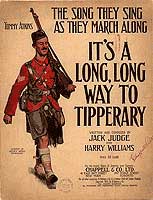 The Daily Mail correspondent, George Curnock, first heard the tune in Boulogne in August, 1914 - "a company of the 2nd* Battalion Connaught Rangers passed us singing, with a note of strange pathos in their rich Irish voices, a song I had never heard before…" The Daily Mail correspondent, George Curnock, first heard the tune in Boulogne in August, 1914 - "a company of the 2nd* Battalion Connaught Rangers passed us singing, with a note of strange pathos in their rich Irish voices, a song I had never heard before…"
It's a long way to Tipperary,
It's a long way to go,
It's a long way to Tipperary,
To the sweetest girl I know!
Goodbye Piccadilly! Farewell Leicester Square!
It's a long, long way to Tipperary,
But my heart's right there!
One of the most popular songs among the British, German and Russian armies during World War I, it sold a million copies in 1914 and was later recorded by John McCormack. But what of its origins?
According to our research, across the water, in Oldbury near Birmingham, England, a music-hall entertainer, Jack Judge, is credited with composing the song along with Harry Williams who was a musician. While Jack had never been to Ireland, it was where his grandparents were from.
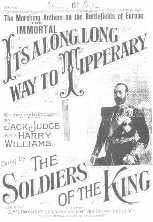 On January 30, 1912, Jack was performing at The Grand theatre, Stalybridge, Cheshire, England with his younger brother Ted Withey. After the performance, he went to a club near the theatre. It was there that someone challenged him with a bet that he could not write a new song and then perform it on stage during the next performance. The bet was for five shillings, which in those days was the price of a bottle of whiskey plus 6 dozen cigarettes. After leaving the club, Jack heard a fragment of a conversation between two men, one of whom said to the other "It's a long way to.........." in the course of giving someone directions. On January 30, 1912, Jack was performing at The Grand theatre, Stalybridge, Cheshire, England with his younger brother Ted Withey. After the performance, he went to a club near the theatre. It was there that someone challenged him with a bet that he could not write a new song and then perform it on stage during the next performance. The bet was for five shillings, which in those days was the price of a bottle of whiskey plus 6 dozen cigarettes. After leaving the club, Jack heard a fragment of a conversation between two men, one of whom said to the other "It's a long way to.........." in the course of giving someone directions.
He seized upon that phrase as a song-title, and then added the word "Tipperary" to it. (In some records, it supposedly started out as Connemara but we can't find any decisive corroboration). His friend, Horace Vernon, wrote down the musical notation by listening to Jack singing the song.
Jack won the bet. He sang "It's a Long Way to Tipperary" for the first time, on the stage of The Grand Theatre during the evening's performance on January 31, 1912. It quickly became a favourite, and its catchy tune soon caught the imagination of the public. Another friend of Jacks was Harry Williams. Harry and his brother kept a small country pub in Oldbury, called "The Malt Shovel". While Jack was an entertainer in the evenings, he had a daytime stall in the local fish market. Harry often lent him money when trade was poor and Jack promised in return that if he ever wrote a best-selling song, he would put Harry's name on it. Jack kept his promise and both men made a small fortune from the song's royalties.
Today, it's still sung at parties, around campfires, at St. Patrick's Day Parades and in Irish pubs from Tipperary to Timbuctu; but in recent memory, perhaps the most emotional rendition came at a very special ceremony that took place in Messines, Holland.
During the First World War, Messines was completely destroyed. For more than three months, bloody battles were fought here, in almost continuous rain, at a cost of 170,000 killed, wounded or missing.
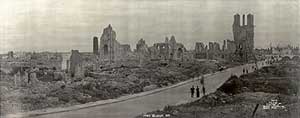 Locally called Mesen, it was a city long before the French Revolution, but lost its title during the Dutch occupation. In 1985, the title was reinstated, thus making Messines - with less than 1,000 inhabitants and a total surface of 900 acres - the smallest city of Belgium. Locally called Mesen, it was a city long before the French Revolution, but lost its title during the Dutch occupation. In 1985, the title was reinstated, thus making Messines - with less than 1,000 inhabitants and a total surface of 900 acres - the smallest city of Belgium.
History was made here; it's a region often remembered in the poem Flanders Field's. Not far away is Boesinghe, where the young Irish poet Francis Ledgewidge was killed while helping to build a road in preparation for the attack on Ypres. He's buried in the Artillery Wood Cemetary nearby.
History was again made here when the Irish State formally honored, for the first time, the quarter of a million Irish people who had served in the British Forces during the first World War. More than fifty thousand of them died.
On November 11, 1998, a monument to those Irishmen who fought and gave their lives in World War I was unveiled by President of Ireland, Mary McAleese, in the presence of Queen Elizabeth II and the King and Queen of Belgium. The monument is a 110 foot Irish Round Tower made from tons of stones taken from a former workhouse in Mullingar, Co. Westmeath. As part of the unveiling ceremonies, the band played It's a Long Way to Tipperary.
Before Jack died in 1938, he composed a sequel called "It's A Long Way No Longer." We have yet to find the lyrics - and we're left to wonder what he wrote. Our wish is that in those last words, he embraced the hope that all Irish soldiers could come home - whether here or in the hereafter - and find peace, at last.
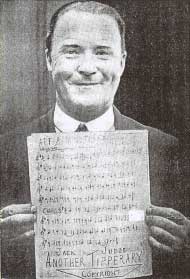 IT'S A LONG WAY TO TIPPERARY IT'S A LONG WAY TO TIPPERARY
Up to mighty London came an Irishman one day,
As the streets were paved with gold, sure ev'ry one was gay,
Singing songs of Piccadilly, Strand and Leicester Square,
Till Paddy got excited, then he shouted to them there:
It's a long way to Tipperary,
It's a long way to go,
It's a long way to Tipperary,
To the sweetest girl I know!
Goodbye Piccadilly! Farewell Leicester Square!
It's a long, long way to Tipperary,
But my heart's right there!
Paddy wrote a letter to his Irish Molly O',
Saying "Should you not receive it, write and let me know!
If I make mistakes in spelling, Molly dear", said he,
"Remember it's the pen that's bad, don't lay the blame on me".
It's a long way to Tipperary,
It's a long way to go,
It's a long way to Tipperary,
To the sweetest girl I know!
Goodbye Piccadilly! Farewell Leicester Square!
It's a long, long way to Tipperary,
But my heart's right there!
Molly wrote a neat reply to Irish Paddy O',
Saying "Mike Maloney wants to marry me, and so,
Leave the Strand and Piccadilly, or you'll be to blame,
For love has fairly drove me silly - hoping you're the same!"
It's a long way to Tipperary,
It's a long way to go,
It's a long way to Tipperary,
To the sweetest girl I know!
Goodbye Piccadilly! Farewell Leicester Square!
It's a long, long way to Tipperary,
But my heart's right there!
Extra wartime verse
That's the wrong way to tickle Mary,
That's the wrong way to kiss!
Don't you know that over here, lad,
They like it best like this!
Hooray pour le Francais!
Farewell, Angleterre!
We didn't know the way to tickle Mary,
But we learned how, over there!
*Some records show that it was the 7th Battalion of the Connaught Rangers Regiment of the British Army. The Rangers were mostly Irishmen, and the regiment had connections with Tipperary Town.
Resources:
Tipperary Fame.
Images: Library of Congress and the site above.
Note: There is much more on Jack Judge and Long Way to Tipperary on Tipperary Fame - it's well worth the visit.
|
|
Fri, Sep 27, 2024
 The Galway Hooker The Galway Hooker
This unique vessel, with its distinctive curved lines and bright red sails, originated in the village of Claddagh. During the 19th century, hookers supported a significant fishing industry and also carried goods, livestock and fuel. Seán Rainey is remembered for building the last of the original boats, the Truelight, for Martin Oliver who was to become the last king of the Claddagh; as king, he was entitled to white sails on his boat. Since the mid seventies, many of the old sailing craft which were on the verge of extinction have been lovingly restored and new ones have been built. During the summer months they can be seen at festivals such a Cruinniú na mBád - the Gathering of the Boats - in Kinvara.
Click for More Culture Corner.
This unconventional perspective helps to shed light on an aspect of Irish nationalism many writers have shamefully and unforgiveably neglected. Writing with passion, the author manifests the exploits of Irishmen and women during the euphemistically renowned "Great War", via the employment of official war sources and contemporary letters from those at the front line. The book sets the scene and the building miasma around some of the war's major conflicts that were to result in serious loss of life borne out of the ineptitude of senior command. In short, it is a lugubrious reflection of the horrors and realities of war, and of the previously "unknown" heroes Ireland can now rightly call its own.
Click here for Irish Voices.
|
More than a quarter of a million Irishmen fought in the Great War. The publication in 1996 of Dungan's Irish Voices from the Great War contributed to the awareness of the injustice done to the Irishmen of the 1914-18 War. This companion volume uses the same type of material (letters, diaries, memoirs, personal interviews) to advance that process.
A companion volume to Irish Voices from the Great War, this book complements that anthology of tragedy with further stories of unromanticised life in the trenches, the experience of POWs, and an illuminating and critical look at the role of chaplains.
Danny Morrison, Sunday Tribune.
Click here for They Shall Not Grow Old.
Thousands of Irishmen lined up at the recruiting stations and served in both the Confederate and Union armies - great names such as O'Rourke, Corcoran, Meagher, McIntosh, McGavock, and Tilghman. Unlike their English neighbors, who, for the most part, assimilated into the Union and Confederate ranks, many Irishmen organized their own, unique units made up of their fellows and included the adjective "Irish" within their regimental names. As their memories disappeared into history, they left their names, their songs and poems, their letters and battle accounts - and their photographs - to remind them of their passing and allow us to walk part of the way with them.
Publisher's Review
Click here for Faces of the Civil War.
|
|
|
|
|




 The Galway Hooker
The Galway Hooker